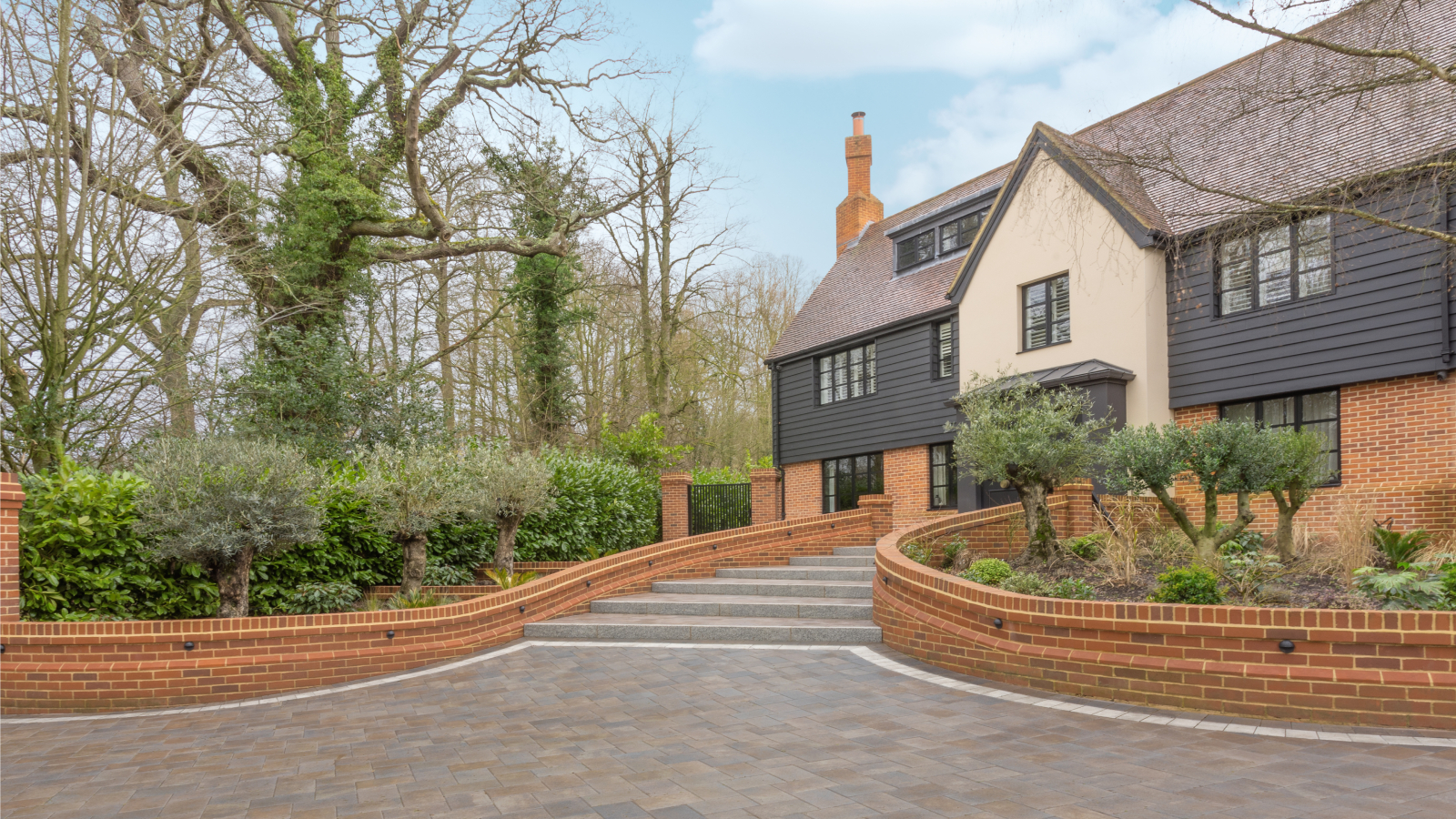Need a soakaway for a driveway? Everything you need to know when upgrading your entrance
If you're updating your entrance you may need a soakaway for a driveway. Here's how to get the size and type right to meet drainage regulations

While installing a new driveway can improve your kerb appeal and add value to your home, it doesn't come without a set of rules and regulations you must adhere to. UK law stipulates that homeowners are responsible for managing surface water on their land.
One of the main elements of this is the required use of sustainable drainage systems, also known as SuDs. It's the term applied to a set of environmentally-friendly techniques – the aim of which is to manage and control surface water runoff.
Soakaways for driveways are one type of SuD that can help you stay compliant with the regulations. But how do you incorporate one in your driveway and how does it work?
What is a soakaway for driveway?
A soakaway for a driveway is a surface water drainage system designed to ensure any water that collects on your driveway – as a result of heavy rain or storms for example – is able to runoff. This is in order to help prevent flooding as well as ensure there is no damage to your driveway, vehicles and any items on it.
Your driveway must be designed to the correct fall, so that the water runs off into your land, rather than onto the road. If you don't have a permeable surface which allows the water to seep through into the ground below, it must therefore be diverted back to your lawn, borders, land drains, or into specialised systems such as rainwater harvesting.
While adding a soakaway to your garden is common practise to prevent water building up on your land, including one in your driveway design is also recommended, particularly if you use certain types of driveway materials.
"Driveways in front gardens need to comply with sustainable drainage requirements," confirms Rosie Wilkins, founder of Rosie Wilkins Landscape Design.
Bring your dream home to life with expert advice, how to guides and design inspiration. Sign up for our newsletter and get two free tickets to a Homebuilding & Renovating Show near you.
"If you’re using a permeable surface, such as gravel or permeable block paving, rainwater can naturally soak into the ground, however, other types of surface coverings are not porous."
In this instance, you will need to consider a driveway soakaway.


Rosie Wilkins studied Landscape Architecture at the University of Sheffield, and now heads up Rosie Wilkins Landscape Design. She enjoys working on both domestic and small public projects.
Is a soakway for driveway the same as a normal soakaway?
When looking at what is a soakaway, “there are various ways a soakaway can be made, such as using the rigid plastic ‘honeycomb’ like structures, which are filled with coarse gravel or similar. This allows rainwater to soak through to the ground, rather than run-off onto the surrounding highways," explains property flood resilience champion, Mary Long-Dhonau OBE – AKA ‘Flood Mary’.
“While there are similarities with regular versions and soakaways for driveways, the main difference is that driveway soakaways must allow for heavy vehicles to park on them with no degradation," she adds, "so they need to be constructed using the right methods and materials.”
“The good news is it is perfectly possible for all developers and homeowners to incorporate SuDS to help make a difference," says Mary Long-Dhonau. “One such option on driveways is permeable paving, which essentially looks and acts like normal paving but when rain falls, it can easily soak through."

Mary Long-Dhonau set up her flood consultancy business, as a result of personal experiences of flooding. She works across the UK to raise awareness of flood risk, property flood resilience, and recoverability.
What size should a soakaway for my driveway be?
The size of your soakaway for your driveway will depend on the rainfall in your area, your soil's water retention as well as the size of your driveway. A percolation test will give you a good idea about how quickly your soil absorbs water, and is therefore a vital first step before building a soakaway.
Mary Long-Dhonau explains: “Size will vary depending on a number of factors, including the size of your driveway area, the number of vehicles that will use the space, and the current flood risk level facing the property in question.
“My advice would be to speak with your construction contractor, civil engineer or a local flood risk surveyor who can provide specific advice based on your situation, while taking into account any local planning regulations.”
How do I install a soakaway for driveway?
A soakaway is, in its most basic form a hole dug into the ground, which is then filled with rubble or – more ideally these days – specialist soakaway crates. This allows surface water additional space to percolate back into the earth in a measured way.
"It’s important to note though that the effectiveness of these systems depends on your soil type," warns Rosie Wilkins. "Heavy clay soils, for instance, are naturally poor draining and will usually need the additional infrastructure of soakaway or storm crates, to support effective infiltration."
The process is laid out in-depth in how to build a soakaway, but essentially involves digging a large hole in the ground and stacking soakaway or attenuation crates, within it. The crates feature voids, allowing large volumes of water sufficient surface area to seep back into the ground.
However, when it comes to soakways for driveways you will also need to double check that they can withstand the weight of the vehicles too. Items such as this robust Graf rain soakaway crate is rated for 60 tonnes and considered perfect for residential soakways.
You then ideally want to use permeable paving or gravel as a driveway surface to allow water to soak through into the ground and soakaway beneath it.
“The installation process for a driveway soakaway typically involves a number of steps," says Mary Long-Dhonau. "However, I advise that you always consult a professional engineer or contractor experienced in drainage to ensure the site is assessed correctly and the excavation, material and final permeable surface is appropriate for your location and the type of soil/subsoil your area has.
“There is no one rule for all areas," explains Mary. "Also remember that once a driveway is installed you should ensure the soakaway is inspected and maintained periodically, to make sure it is functioning correctly.”
FAQs
Do I need planning permission to install a soakaway in my drive?
While installing a soakaway itself would not need planning permission, installing a driveway often does need driveway planning permission when permitted development rights do not apply. Therefore when installing a soakaway for a driveway you may end up needing to include the details of this in your planning application.
Mary Long-Dhonau confirms: “You need planning permission to lay a brand new driveway, however your local authority will look favourably on any moves you take to remove surface water flood risk.
“In general, it’s essential to check with your local planning authority as the need for planning permission may also vary depending on your specific location, local regulations and scope of the work. For example, the property may be in an Area of Outstanding Natural Beauty and therefore rules may be tighter on what you can or can’t do.”
What are the other types of SuDs?
SuDS (sustainable drainage systems) takes into account a combination of methods, from ponds, swales, and soakaways to tree pits, permeable paving and water harvesting, to name just a few.
The aim of SuDS is to mimic natural water management processes by allowing water to infiltrate into the ground, evaporate away, or be stored again for later use, rather than immediately diverted into traditional drainage systems.
Wondering how the addition of a soakaway will impact your budget? Find out what you can expect to pay for driveway costs and familiarise yourself with the different types of driveway materials so you can weigh up whether investing in a permeable surface is a more cost-effective solution.
Sam is based in Coventry and has been a news reporter for nearly 20 years. His work has featured in the Mirror, The Sun, MailOnline, the Independent, and news outlets throughout the world. As a copywriter, he has written for clients as diverse as Saint-Gobain, Michelin, Halfords Autocentre, Great British Heating, and Irwin Industrial Tools. During the pandemic, he converted a van into a mini-camper and is currently planning to convert his shed into an office and Star Wars shrine.

